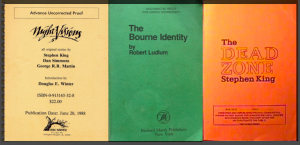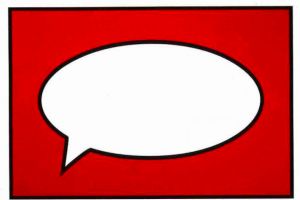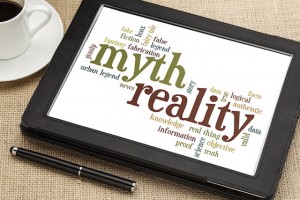Posts by Sharon Bially
Seeing your book on the silver screen: it’s a universal dream, one that nearly every novelist I’ve worked with has confided that they harbor. Barely a day goes by when an author does not ask me whether I have any Hollywood connections who could help them get a foot in the door.
Sure, I have some loose contacts in “The Industry.” A screenplay writer here, a director there, a financial VP. But that doesn’t mean I can slip someone a manuscript and open doors. Far from it. In fact, how and why certain books get made into movies is a complete mystery to me — as it is to so many others.
Which is why, when I recently met the co-founder and president of production and acquisitions at an L.A. production company associated with Showtime Networks, CBS Films and Netflix over a conversation about a book he was considering making into a movie, I asked if he’d talk me through the process of how, exactly, novels are discovered by the film industry.
I’m delighted that he’s agreed to do so “on the air” here at Writer Unboxed. A warm welcome to Brett Tomberlin of Imagination Design Works (IDW).
Q: In general, where do the ideas for the movies you decide to produce come from?
BT: In most cases scripts come to us though attorneys or agents. Since there are so many lawsuits, you have to be super careful in Hollywood to only take material from an attorney, a manager or an agent with all the legal bases in place.
Sometimes people come in without a script but with a concept. These are usually people we know and have worked with. We know their track record and their capabilities, so we’ll talk to them.
And we do get people coming to us with books. As long as the book is published – whether traditionally or self-published – we can look at it because its publication is a time stamp showing it’s been released out into the public. Legally, this works for us.
Q: About how many of the ideas you get come from books?
Read MoreDeep down inside we writers know that those pie-in-the-sky dreams we all harbor of getting our books reviewed by the New York Times, or featured in Oprah Magazine or on NPR’s Fresh Air are, for the most part, just that: pie-in-the-sky-dreams. A few years back here on Writer Unboxed I gave a glimpse of why.
But let’s fess up: somewhere even deeper down inside, right next to the ache in our heart we’ve been trying to assuage throughout years of solitary drafting, querying and facing the sting of rejection over and over again, is a dense nugget of hope that those pie-in-the-sky dreams will come true. After all, the the New York Times does review a good handful of books. We tell ourselves silently, “one of them could – and should – be mine.”
In my work with authors, I hear this wish articulated over and over again. And I want nothing more than for that wish to come true. When it does — whether we’ve landed a story for one of our authors in The Washington Post or a feature on BuzzFeed, or firmed up an interview with NPR or MSNBC — my team and I text each other in excitement. We stop everything to watch or listen to the interview live. In part, our excitement reflects the fact that this type of high level coverage is painfully rare.
You might think that if you don’t make it to that level of coverage, you’ve failed. That your publisher or publicist has failed. As Kathy Sherbrooke, author of the exquisite debut Fill the Sky recently said to me, “We tend to associate success with what we see “regularly,” i.e., in the major press outlets that we frequent: major newspaper reviews, coverage in significant trade publications and TV interviews.”
Read MoreAt the risk of making everybody’s eyes glaze over, today I’d like to talk a bit about one of those hands-on, practical issues that’s key to any book’s life cycle but totally unsexy: Galleys.
No, this has nothing to do with seafaring or food.
The truth is, there’s a lot about writing and publishing that’s not only unsexy but – as my French husband likes to say about certain other things – real “love killers.” (Picture husband sneering at my comfy fleece PJs and saying, “un vrai tue-l’amour.”)
But like with those PJ’s, we’ve just got to have them. Editing, revisions, production timelines, marketing, sales reports…. These are just as important to your book as those sexy, dazzlingly inspired late-night write-athons we’d all much rather be talking about.
Galleys are one of these things. While we’d love to ignore them and just keep writing, if we do they’ll eventually get in our way. (Just like those PJs…) Because at some point, most authors publishing and publicizing a book will need to understand galleys and make decisions that involve them. Otherwise, vetting your book and getting it the visibility it deserves becomes extremely complicated. I’ve seen this happen all too often.
Many of you have probably already heard the word “galleys” floating around in writerly circles. But I’ll bet that you’re not exactly sure what it means. So let’s start with their definition.
In essence, galleys – which are typically created up to 5 months or so before your pub date – are a preliminary version of your book used by your publisher for various purposes before the final copy is ready. Sometimes called “galley proofs” or “uncorrected galley proofs,” they might still have typos or even sections that need some tweaking. Often the cover has not been designed yet, and instead, is a temporary layout showing basic info such as the title, the publisher’s name, your name and the publication date. Or the cover might be partially designed so that the front is in pretty good shape but the back has a lot of space left to fill. That’s where, ultimately, blurbs should go.
Yes, they’re usually ugly. Like fleece PJs. But like the PJ’s, they’re also practical. Beauty aside, there’s a lot they’ll be used for:
What if, like so many authors nowadays, you’re with a small press that doesn’t produce galleys at all? Or are self published?
Read MoreIt’s the scenario every writer dreams of: #1 New York Times Bestsellers. Movie deals. Book deals for 10 novels, one after the next.
Who could ask for more? Yet in the crazy world of publishing, even this stellar trajectory does not necessarily translate into the professional or financial stability most people need.
That’s why Nicola Kraus, whose novels, co-authored with Emma McLaughlin, include blockbusters such as The Nanny Diaries, So Close, The Real Real and Nanny Returns, turned a page in her own career a few years back to add professional ghostwriting and editing into the mix. Ever fascinated by how writers leverage their unique creative skills into satisfying, sustainable careers, I caught up with Nicola recently to hear about her path. Her work has been a great source of inspiration to me, so I’m all the more honored to speak with her here today. Let’s dive in.
Q: You’ve written and co-authored 10 wildly successful novels, including the New York Times bestseller The Nanny Diaries — which was made into a movie starring none other than Scarlett Johansson. How did you make the jump from crafting fiction to editing and ghostwriting nonfiction?
NK: Well, it wasn’t so much a jump as an evolution with so many factors :) When my co-author Emma McLaughlin and I started publishing fiction in 2002 it was easier to sell enough primary and foreign rights that two people could split the revenue from one book and live in New York City. But after 2008 foreign sales became increasingly rare. Magazines stopped serializing fiction, and six-figure film sales were phased out in favor of four-figure film options.
If we had been one person living outside the city we would have been in great shape, but after we had children we were forced to make some tough decisions about what we wanted to be getting out of our time away from them. At that point our responses diverged. She decided to go back to corporate life and I decided to immerse myself in what I loved about writing in the first place: not just the craft, but the art and magic of it. I did that by starting to teach, or ‘coach,’ aspiring authors, giving myself the financial freedom to go back to making art for the creative pleasure of it.
Q: There are all sorts of misconceptions about what “ghostwriting” really means, and there seems to be a stereotypical notion that it involves sitting down and writing somebody else’s book from scratch. But I’ve seen all sorts of permutations, from helping authors get their first drafts into final shape to polishing already-solid manuscripts. Tell us how you work.
NK: Lol! No, I don’t put words in anyone’s mouths! I have manifold ways of working with clients. And they all stem from one fact: as publishers merged and were bought out in the oughts, houses started employing fewer and fewer editors, but published more and more titles. Meaning authors now need people like me to help them do what they could once have found within an in-house author/editor relationship. […]
Read MoreWhen approached by self-published authors for help with book promotion, I used to ask a single question:
“Do you have blurbs from at least two established authors?”
If the answer was no, I’d suggest they gather some before we speak. Blurbs are an essential piece of the vetting process and vetting is crucial to gaining the media’s interest. All the more so for self-published books, which don’t have the benefit of a publishing house’s stamp of approval.
While I still request blurbs, I’m beginning to think there’s another question I should ask self-published authors considering a PR campaign:
“Did you query literary agents for at least six months before deciding to self-publish?”
From down here in the PR trenches, this has nothing to do with whether an author opting to self publish tried to get a traditional publishing deal or how that went. It makes little difference to me whether somebody “almost” had an agent, got glowing rejection letters or received dozens of full manuscript requests. I’m not looking at agent interaction as a form of validation, since in the end, the only real form of validation from an agent is a contract.
Rather, the experience of querying agents provides crucial preparation for the experience of book promotion.
As we all know, the process of querying is charged with hope and expectation, trepidation and angst. Each query letter contains a piece of our heart; each inevitable rejection letter — or lack of response — breaks our heart in its entirety. The waiting and uncertainty break our spirit. Yet from these wounds grow the emotional armor we need to keep at it, the patience and resilience that allow us to shrug in the face of prolonged uncertainty and above all, the deep humility that is fundamental to every writer’s survival, and success.
It may come as a surprise, but the experience of book promotion has a lot in common with the querying journey. Your publicist is, in essence, querying reporters and reviewers on your behalf. With the market for book news and reviews just as crowded and competitive as the literary marketplace itself, your publicist will be getting far more rejections than hits. In fact she or he may send out hundreds upon hundreds of email pitches and many dozens of hard copies of your book to yield but a tiny handful of news items.
Read More
The question of how important book promotion is to sales and an author’s career is the subject of continual, heated debate.
On one hand, many agents these days urge their clients to hire an outside publicist no matter who their publisher is, claiming that without robust PR and promotion no book (or author) has a future. On the other hand, many — like WU’s own Donald Maass — stress the greater importance of staying focused on writing, insisting that the real ticket to sales is to craft a killer book. Combined with the fact that the level of efforts publishers make varies wildly and publishers’ in-house teams often shrug indifferently when authors ask if it’s worth hiring help, this makes for a lot of mixed messages, ambivalence and confusion.
Add to that the unclear correlation between promo efforts and sales and the entire issue starts to look like a riddle that’s impossible to solve.
Over the years, though, I’ve noticed one surprising pattern that might offer an answer for many:
When successfully implemented BEFORE a manuscript is even shopped around, book PR can have quite a profound impact, one that will ripple out well into the future.
I know, you’re probably thinking, “Huh? Has she lost her mind?” After all, how can you promote a book while in essence it’s still a work-in-progress?
While it’s true that at such an early phase you can’t promote a book per se, what you can do is promote yourself: your name, your background, your voice and your ideas. As the author, you are the persona behind your work. Thus promoting the book and promoting yourself are one in the same.
Authors who promote themselves in advance of searching for an agent or simply find themselves in the fortuitous position of having an existing media platform enjoy a number of distinct advantages when it comes time to shop that manuscript:
Read More
“What can I do to get my book onto a bestseller list?”
If I had a dime for each time an author has asked me this question, I wouldn’t need to be a bestseller myself to be rich. Until recently though, my answer has always been a disappointing, “I have no idea.” Or, “There’s nothing anyone can do.”
Then I had a fascinating conversation with the team over at Greenleaf Book Group, an independent publisher and book distributor. Greenleaf not only helps develop ideas into books which they then publish, promote and distribute they also also work with qualifying authors to make that bestseller list dream come true. And they’re successful at it.
What I learned was so eye-opening that I’ve invited Greenleaf marketing associate Magdalene Thomas to talk with me about strategies for reaching those bestseller lists in a Q&A here on Writer Unboxed. Magdalene’s work planning and executing strategic marketing campaigns with independent authors has resulted in numerous bestseller placements.
Welcome, Magdalene. Let’s dive in!
SB: When I heard that there are actually steps authors can take to help their books hit bestseller lists, I had to hit the universal reset button. Is it true?
MT: Yes, there really are steps that certain authors with the serious goal of becoming bestsellers can take. They primarily involve controlling volume and velocity of sales.
SB: That sounds so easy. What’s the rub?
MT: Every time I develop a marketing campaign for one of the many authors I work with, I ask: “What are your goals for this book?” Nine times out of ten, their response is some iteration of “I want to have a best seller.”
As someone who is acutely aware of the realities of placing on a best-seller list, I have to take a deep breath before I respond. Hitting a bestseller list is the ultimate validation of an author’s time, emotion, energy and ideas. Yet planning for this takes resources and the outcome is not guaranteed. So even though I can help my authors take the necessary steps, I also have to help them set expectations and encourage them to set more realistic goals.
There is a time and place for marketing campaigns focusing on high-level bestseller lists such as The New York Times. That type of campaign is not right for every book and author. Luckily there are also other types of bestseller campaigns that are more accessible, like on Amazon. It’s important for authors to assess which if any of these are best given their specific situations.
SB: What situations lend themselves to working toward placement on national bestseller lists like the New York Times or Wall Street Journal?
MT: A push for placement on a third-party best-seller list like The New York Times works best if you have an existing audience that is primed to purchase your book as it hits shelves.
These best-seller lists are determined by sales numbers within a
Read More
Valentine’s Day is just around the corner, which for couples everywhere means ramped up romance complete with gifts of roses, chocolate, jewelry — perhaps lacy lingerie.
For writers whose novels contain even an inkling of romance, Valentine’s day may bring love to mind but also stirs up notions of something a lot less sexy: marketing. Because with love in the air, any novel where romantic love is a central theme — especially a straight-up romance — has the potential to generate lots of buzz.
At least that’s the thinking behind the sudden upsurge in online ads and social media posts about books with an amorous angle. Yet just as each year in early January I receive a spate of queries about potential Valentines Day PR initiatives, each year on February 15 I receive a big batch of emails from authors who are dismayed that their efforts fell flat.
First, a fact: I don’t do special Valentine’s Day PR pushes — nor do I get involved with special initiatives around the two other big holidays books try to peg to: Christmas and Halloween. That’s because true to the nature of market timing in general, I have yet to see results that convince me of its value for books.
Sure, at certain times of the year there’s an abundance of visibility opportunities to leverage. The social mediasphere, for one, is abuzz with conversation snippets about chocolate and roses right around now, Santa and snowmen in December, ghosts and ghouls in the fall. News outlets cover stories in the spirit of each season, and advertising everywhere takes on a tinge of red and green, or black and orange — or this week, pink.
Still, this doesn’t mean that suddenly demand for related books will spike. Think about it: romance readers will choose romance over other genres year-round. As will crime, suspense and horror book fans. At the same time, with thousands or possibly hundreds of thousands of authors all hoping to ride the wave of special days simultaneously (not to mention purveyors of all sorts of other products with similar hopes), the market quickly becomes saturated, the noise deafening. It can be overwhelming for readers to sift through the influx of ads and information and make a choice.
Read MoreYour manuscript is finished and the agent submissions checklist is all set:
Or perhaps you’ve decided to self-publish and everything’s ready, including a cover designed around a gorgeous image you’ve found that perfectly captures the spirit of your book.
It’s time to pull the trigger.
But wait. Isn’t something missing?
If either your querying materials or your self-published cover do not include blurbs, then yes: something’s missing. Something you absolutely can’t proceed without.
Quick primer in case you’re not familiar with this quirky term:
A “blurb” is that little snippet of praise from another author or a reviewer brandishing a book’s cover. Think, “Immensely readable. From small town to the grit of the city, family farm to union factories, the Midwest of Michelle Hoover’s Bottomland is alive with secrets, hard choices, and the acute costs of independence.” —Daphne Kalotay, author of Russian Winter and Sight Reading
Or, “Half in Love With Death is a suspenseful psychological thriller and a mesmerizing coming of age story. I raced to find out what happened, yet longed to linger with this rich cast of characters and Emily Ross’s stylish prose. This haunting story of a teen girl’s search for her missing sister, served up with plenty of plot twists, will excite YA mystery fans.” —Diana Renn, author of Tokyo Heist, Latitude Zero and Blue Voyage
These well-crafted snippets not only showcase readers’ praise of a book, but they also serve a very important purpose long before a book is marketed or promoted:
At every phase of the game, blurbs offer a crucial layer of vetting.
In an industry where where no specialized training or prior experience is required to go knocking on agents’ or editors’ doors, blurbs help distinguish those writers who’ve done their homework by seeking critiques from others more experienced than themselves. They also demonstrate that a manuscript has gone through the requisite rounds of revisions and rewriting and is at the point where a published author can read it start to finish and approve.
Read More
“Dear publicist, My book just released and I’d like to promote it. How can you help?”
“Hi! My novel came out last fall and sales have been close to zero. Can we talk about what your firm can do to promote it?”
Ouch! These emails break my heart.
I typically get about two like this a day asking for help with a book that has already released. Or is releasing next week. Or tomorrow. Sadly, in those cases there’s a lot less I can do than I could have two or three months earlier.
That’s because the work of getting a book onto the radar screen of people in the media who will review it, blog about it or interview its author must absolutely begin well in advance of publication.
I know it sounds counterintuitive: at long last a book has hit the market, it’s time to tell the world! But in fact, this is a far cry from how things work on the back end.
To understand why, we need to get inside the minds of the people on the back end — those who will be writing those reviews, conducting those interviews or publishing your blog posts. In order to even consider a book for coverage, the person doing so usually needs to read first, and then craft a thoughtful news item about it — whether that’s a review, a feature story or an author Q&A. He or she will also have to get the news item approved and possibly revised by an editor, who’s equally swamped and running chronically behind. And chances are, said person already has a pile of about 20 other books to read or consider first. It’s not unlike the process agents go through where their slush piles just keep growing but there are only so many hours in a day.
Yet this is completely at odds with the imperatives of organizations offering coverage such as magazines, newspapers, radio stations and sites like The Huffington Post. These organizations are news outlets. So are may blogs, including book blogs. By definition, news is information about what’s new. Take a look at your daily newsfeed, or turn on the evening TV news: each article or story contains information or commentary relevant in some way to an event that has taken place that very day, or to one that took place very recently and is still being buzzed about. So news outlets have to give priority to what’s new or timely.
Read MoreAs writers, we all know how hard it is to read a book without dissecting, critiquing or copy editing in your head.
As a publicist (and a lapsed writer), I can’t help giving the same scrutiny to every email and newsletter blast that lands in my inbox. Sad, perhaps, but true.
That’s because, whether you realize it or not, certain emails are actually important marketing pieces that have writing requirements of their own — just the way fiction does. Those announcing your book’s publication, those telling the world about your launch party or a reading you’re giving. Emails you send to booksellers inquiring about holding an event are marketing pieces, too.
So for this lazy August Monday I offer a simple, summer-read caliber bit of advice about how to make sure that promo-related email you’re about to send doesn’t get deleted immediately or relegated to the “read later” file while your friends’ are off vacationing, only to be forgotten when they return:
It’s all about the subject line.
Typically we think of that little field as an afterthought of sorts we have to figure out how to fill with…something. Since it’s a bit of a nuisance, we may be tempted to shirk it by just plugging in a neutral phrase requiring little or no thought. Something like, “Hi.”
The problem is, just like with fiction, you need to grab your audience’s attention with an engaging and well-crafted one-line summary of what they can expect if they open the book (or the message) and read it. For books, that description is called the logline. And when it comes to emails related to the marketing of your work, that’s exactly how you should think of the subject line: as a logline.
I see a lot of subject lines that are vague and offer no specific information on what I can expect when I open the message. These are the polar opposite of loglines. For example:
Read MoreIf you’re thinking of hiring a publicist, one of the first questions you’re likely to ask is:
“Do you have good contacts?”
Authors ask me this every day. While it would be easy for me to say, “Of course!” (and to add with a glint in my eye, “if you just sign on this dotted line,you’ll see…”) it would be misleading. Not because I don’t have contacts. Rather, because the very notion that contacts will lead to media placements is a great big myth it’s time to dispel.
Think about it. Our press corps is immense. Far beyond book reviewers, there are bloggers and producers and editors and staff writers covering every topic under the sun from food and travel to fashion, psychology, money, health and gardening — even adhesives. Seriously. My Vocus media database boasts an archive of 1.6 million media contacts and growing.
Like most PR pros, my work, too, spans a wide range of topics. I’ve promoted everything from business books to crime novels and literary fiction. While publicizing Alden Jones’ dazzling travel memoir The Blind Masseuse, I reached out to reporters covering travel and specific Latin American countries. For Lisa Borders’ literary novel The Fifty First State set in southern New Jersey, I was in touch with — you’ve got it — the South Jersey press. (Yes, there is such a thing.) While working on Ashley Warner’s rape memoir The Year After I dug up names of reporters who focus on women’s health. I also figured out who happened to be producing news about the college campus sexual assault stories that were making headlines at the time. The list goes on and on.
Can anybody possibly know all these contacts? Absolutely not. That’s what databases are for. Besides, the media is notorious for high turnover. A great contact who’s here today could very well be gone the next.
Instead, what a good publicist knows is how to find the news angle in any given book or project. Because the single most important factor in garnering coverage is the story itself. Reporters, reviewers, bloggers, producers and news editors are all looking for specific types of news stories presented in fairly specific ways. Mining those stories from each given book and each author’s personal history
Read MoreHow’s this for a story:
For the past 18 months, Chris’s ex has forbidden her to see their young daughter. Not because Chris has harmed her daughter, violated any agreements or broken the law, but — as Chris sees it — because she recently completed her transition from male to female. Chris is transgender.
Since she began her transition 5 years ago, her entire family has shunned her. She’s been disinvited to Christmas, to birthday celebrations and other activities. Members of her family have verbally abused her, calling her grotesque, sick, deranged and psychotic. “If you were a real man you would have just killed yourself,” they told her.
Devastated by the lack of support from her once close-knit clan at a time of intense vulnerability, Chris did, in fact, once try to take her own life.
Today, as she struggles to regain her footing in the world, she is fighting a costly uphill court battle over her parental rights, mired in discrimination.
This may sound like rich fodder for a page-turning novel. But Chris is not a fictitious character. She’s my client. And it’s been years since I put fiction-writing aside to focus instead on bringing real-life dramas and narratives to the world not in books, but on the pages, screens and air waves of the media.
Chris has hired me to promote her children’s book, My First Red Sox Game. Stripped of all other means to communicate with her daughter, she wrote it in hopes her daughter will read it one day. It’s inspired by memories the two once shared.
Like with any other book, the backstory to My First Red Sox Game extends far beyond the plot into Chris’s personal life: her past, her pain, her dreams. To find and connect with its audiences, I need to dig into that backstory and
Read More- « Previous
- 1
- 2
- 3
- 4
- Next »




















